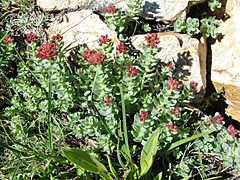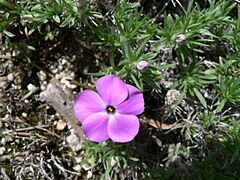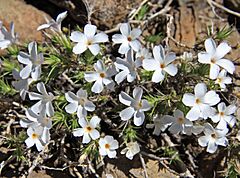Flora of the Sierra Nevada alpine zone facts for kids
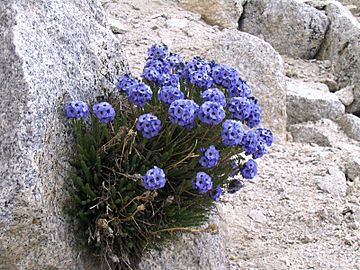
The plants of the Sierra Nevada alpine zone are special. They are small and grow close to the ground. These plants can survive tough conditions. They live in the high-altitude alpine zone, above where trees can grow. This area is called the timber line.
Botanists say the Sierra Nevada alpine zone has amazing wildflowers. They are known for their bright colors and large numbers. Many alpine flowers have big, showy blooms. This helps them attract pollinators during their short growing season. Botanist Philip A. Munz called these areas "spectacular sights." Another botanist, Laird R. Blackwell, said the flowers "seem to glow."
Most of California's alpine plants are perennial herbs. This means they live for more than two years. Plants that live only one year (annuals) are not common here. The Sierra Nevada alpine zone has almost 600 plant species. About 200 of these are found only here. Some plants are relict plants. This means they are descended from plants that survived the last ice age. They grew on mountain peaks that stuck out above the ice.
Contents
How Plants Survive in the Alpine Zone
The alpine zone is above the tree line. It's usually at 11,000 to 11,500 feet (3,400 to 3,500 m) in the south. In the north, it's about 9,900 feet (3,000 m) to 10,500 feet (3,200 m). Plants here face many challenges.
Tough Conditions for Alpine Plants
Plants must survive very long, cold winters. The soil is poor or missing. Strong winds blow all the time. Sunlight is very intense. The summer growing season is short, cool, and dry. It lasts only about 6 to 8 weeks.
Winds are strong and constant. They make unsheltered areas much colder. Winds also blow snow around. This leaves some spots bare and others covered in deep snow. Strong winds also make plants lose water quickly. Sunlight is very bright. The soil is thin, rocky, and often dry. Most of the yearly rain (35 to 40 inches (0.89 to 1.02 m)) falls as snow. Plants must grow, flower, and make seeds very fast.
Amazing Ways Alpine Plants Adapt
Trees cannot grow above the tree line because of the strong winds. The constant wind keeps plants small and flat. Most alpine plants are only a few inches tall. This small size helps them survive the extreme conditions. One botanist said plants "scrunch down close to the ground." Their leaves often grow in dense mats or cushions.
Alpine plants have many ways to deal with dry conditions and intense sunlight. Their leaves often look gray. This is because they are covered in hairs. These hairs reflect bright sunlight. They also protect plants from winds that cause water loss. Many Sierra Nevada alpine plants have reddish or whitish leaves. This protects them from strong ultraviolet light.
Plants store food in their fleshy roots and underground parts. This helps them grow quickly when the snow melts. Many plants even form flower buds the summer before they open. This allows them to bloom fast during the short growing season.
Where Did These Plants Come From?
The alpine plants of the Sierra Nevada developed fairly recently. They came from plants in western America. During the last ice age, some mountain peaks were not covered by ice. These peaks are called nunataks. They became safe places for plants to live. An example is the Dana Plateau at Tioga Pass. Half of all alpine plants in the Sierra Nevada can be found there.
Many species also grow in the Cascade Range and Rocky Mountains. Examples include Penstemons (Penstemon spp.) and Polemoniums (Polemoneaceae spp.).
A small group of Sierra Nevada alpine plants are found all over the world in northern areas. This is called circumboreal distribution. Bush cinquefoil (Potentilla fruticosa) is one example. It grows in arctic regions like Alaska and Labrador. It is also found in high mountains in Eurasia.
Types of Alpine Plants

About half of the alpine species are broad-leaved, upright perennials. Grass-like plants (graminoids) make up about 21%. Plants that grow as mats or cushions are about 11%. Annuals and woody shrubs are only about 6% of the total.
There are over 500 plant species above 3,300 metres (10,800 ft). Almost 400 species grow above 3,500 metres (11,500 ft). Nearly 100 species reach 4,000 metres (13,000 ft). More than 25 species grow above 4,200 metres (13,800 ft).
Six plant families include more than half of the alpine zone species. The sunflower family (Asteraceae) has about 55 species. The grass family (Poaceae) has almost 40 species. The mustard family (Brassicaceae) has 34 species. Sedges (Cyperaceae) have over 30 species.
The largest group of plants is Carex, the "true sedge." It has about 50 species above 3,300 metres (10,800 ft). Next is Draba in the mustard family. Then comes Lupinus in the legume family (Fabaceae) with about 10 species.
Almost 70 species (about 17%) are found in both subalpine and alpine areas. Over 25% grow from the alpine zone all the way down to foothill areas. Nine species are found only in the alpine zone above 3,500 metres (11,500 ft).
Annual Plants
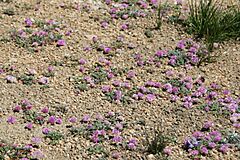
Annual plants and woody shrubs are only a small part of the Sierra Nevada alpine plants (about 6%).
Sierra gentian (Gentianopsis holopetala) is in the gentian family (Gentianaceae). It can be an annual or perennial. It grows in wet meadows from 6,000 to 13,000 feet (1,800 to 4,000 m).
Toothed owl's clover (Orthocarpus cuspidatus) is not a true clover. It belongs to the broomrape family (Orobanche).
Low growing pussypaws (Cistanthe umbellata) is in the purslane family (Portulacaceae). It usually grows in damp, partly shaded spots. It can be found as high as 14,000 feet (4,300 m). It has stems that spread out along the ground. When the ground gets warmer, the stems rise up.
Perennial Plants
Perennials are plants that live for more than two years. They are often small and low-growing. They can be upright or form mats or cushions. Upright perennials with broad leaves make up 50% of the alpine species. Mats and cushions make up 11%.
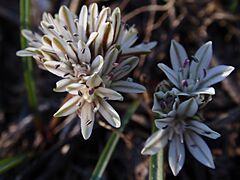
Swamp onion (Allium validum) is a perennial bulb in the onion family (Alliaceae). It grows in alpine wetlands up to 11,200 feet (3,400 m). The red sierra onion (Allium obtusum) has a low head of flowers that looks like it's sitting on the ground.
In the carrot family (Apiaceae), Clemen's mountain parsley (Oreonana clementis) forms a dense mat of tiny plants. It can cover several square yards. Sierra podistera (Podistera nevadensis) is compact and stemless. It is found only above the timberline, up to 13,000 feet (4,000 m).
Sunflower family (Asteraceae) perennials include western snakeroot (Ageratina occidentalis). This upright plant grows up to 12,100 feet (3,700 m). Flat-topped pussytoes (Antennaria corymbosa) is a small, mat-forming plant. It spreads using tangled underground stems. Other similar plants are rosy pussytoes (A. rosea) and Alpine Everlasting (A. media). Alpine aster (Aster alpigenus) can have stems lying on the ground or standing upright. It grows up to 12,000 feet (3,700 m).
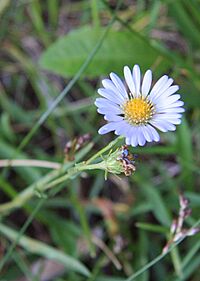
Alpine fleabanes, or daisies, are also in the sunflower family. Dwarf mountain fleabane (Erigeron compositus) is a good example of alpine growth. Its flower heads are very large compared to the plant's small size. It grows as a mat or cushion on rocky slopes up to 14,000 feet (4,300 m). Rambling fleabane (E. vagus) also grows to 14,000 feet (4,300 m) but is only 2 inches (5.1 cm) tall. Dwarf daisy (E. pygmaeus) forms a compact cushion. It gives vivid color to the alpine zone. Its flowers sometimes cover the leaves and rocks below.
Golden yarrow (Eriophyllum lanatum) is found up to 13,000 feet (4,000 m). It is not a true yarrow. Foul smelling alpine gold (Hulsea algida) grows only on talus (piles of rocks) and rocky peaks up to 13,000 feet (4,000 m). It is unusually "tall" for an alpine plant, with stems reaching 1+1⁄2 feet (0.46 m).
Anderson's mountain crown (Oreostemma alpigenum) is another upright perennial in the sunflower family. It is found below 11,500 feet (3,500 m). Alpine rock butterweed (Packera werneriifolia) grows on dry rocky slopes to 13,000 feet (4,000 m). Silky raillardella (Raillardella argentea) has fleshy leaves covered in silvery-white hairs. It grows to 12,000 feet (3,700 m) or 13,000 feet (4,000 m). "Argenta" means "silvery," referring to its leaves.
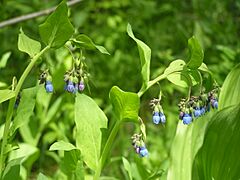
The borage family (Boraginaceae) includes low cryptantha (O. humilis). This small, hairy plant has dense, leafy stems. It is found up to 11,900 feet (3,600 m). Sierra forget-me-not (O. nubigena) grows even higher, to 12,900 feet (3,900 m). It is covered with stiff, bristly hairs to protect it from dry winds. Streamside bluebells (Mertensia ciliata) grow in shaded, moist areas to 12,000 feet (3,700 m).

The mustard family (Brassicaceae) has broad-seeded rock-cress (Arabis platysperma) growing to 12,000 feet (3,700 m). Lemmon's draba (Draba lemmonii) is hairy and mat-forming. It has clusters of lemon yellow flowers. It grows in rock crevices. Western wallflower (Erysimum capitatum) grows to 13,000 feet (4,000 m).
Pink family (Caryophyllaceae) member nuttall's sandwort (Minuartia nuttallii) is a ground-hugging mat. It has short, needle-like leaves. Sargent's campion (Silene sargentii) is found in rock crevices to 12,000 feet (3,700 m) or 12,500 feet (3,800 m).
Rosy sedum (Rhodiola integrifolia), in the stonecrop family (Crassulaceae), has fleshy leaves. These leaves store moisture. Western roseroot (R. roseum supbsp. inegrifolium) is also fleshy. It is found up to 13,000 feet (4,000 m) in moist, rocky places.
The legume family (Fabaceae) includes balloon milkvetch (Astragalus whitneyi). It has papery, balloon-like seedpods filled with air. Brewer's lupine (Lupinus breweri) forms mats. It is well adapted to the alpine zone. It is low-growing and has hairy silver leaves. These leaves reflect sunlight and trap air. This helps reduce drying from constant winds.
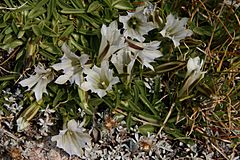
Explorer's gentian (Gentiana calycosa), in the gentian family (Gentianaceae), is a noticeable flower in moist alpine meadows. It has deep blue, bell-shaped flowers. It is found as high as 13,000 feet (4,000 m). Alpine gentian (Gentiana newberryi) blooms late in the alpine zone. It grows in moist meadows up to 13,000 feet (4,000 m).
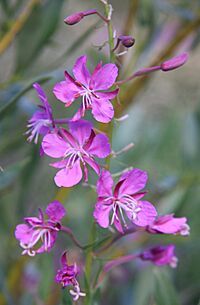
Fireweed (Chamerion angustifolium), in the evening primrose family (Onagraceae), is named for its bright color. Rock fringe (E. obcordatum) grows on dry slopes. It forms mats that spread across rocks. It looks like a bright fringe on the edge of moist rocky ledges.
Ladies Tresses (Spiranthes romanzoffiana) is a sweet-smelling member of the orchid family (Orchidaceae). It has a spiral of flowers.
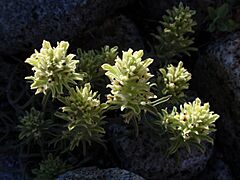
Lemmon's paintbrush (Castilleja lemmonii), in the broomrape family (Orobanchaceae), is found in alpine meadows or dry, rocky places to 12,000 feet (3,700 m). Dwarf alpine Indian paintbrush (Castilleja nana) grows in dry alpine areas to 12,000 feet (3,700 m). It is very small, usually less than 4 inches (10 cm) tall. Little elephants head (Pedicularis attollens) grows as short as 2 inches (5.1 cm) and to elevations of 13,000 feet (4,000 m).
The poppy family (Papaveraceae) has steer's head (Dicentra uniflora) and few-flowered bleeding heart (D. pauciflora). Each grows to 12,000 feet (3,700 m).
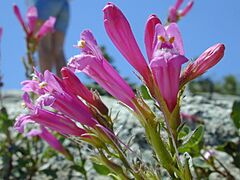
In the plantain family (Plantaginaceae), Davidson's penstemon (Penstemon davidsonii) is a perennial spreading mat. Its tubular flowers are longer than the small plant that holds them. Penstemon heterodoxus can be as small as 2 inches (5.1 cm). It usually forms mats up to 8 inches (0.20 m). It grows up to 12,000 feet (3,700 m). John Muir's favorite wildflower, mountain pride (Penstemon newberryi), "carpets granite slopes with brilliant pink flowers."
Phlox family (Polemoniaceae) perennials include dwarf phlox (Phlox condensata). It forms dense cushions. Its tiny leaves are only 0.2 inches (0.0051 m) long. This helps it resist high winds. Its flowers form a solid blanket over the plant. Spreading phlox (Phlox diffusa) is a matted perennial with sprawling stems. At very high elevations is sky pilot (Polemonium eximium). It grows on rocky peaks to 13,800 feet (4,200 m). It is considered "one of the finest and most beautiful Sierra wildflowers."
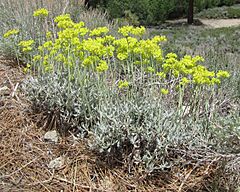
Buckwheat family (Polygonaceae) perennials include lady's thumb (Bistorta bistortoides). It grows from a twisted underground stem. Butterballs (Eriogonum ovalifolium) has leaves that grow very tightly. They form thick mats or cushions on sandy or rocky ground. It grows up to 12 inches (0.30 m) or 13,000 feet (4,000 m). Frosted wild buckwheat (E. incanum) is covered with white hairs. It looks "frosted." It grows to 13,000 feet (4,000 m).
Another buckwheat family member is naked stemmed eriogonum (E. nudum). It has 13 different types. It grows from the desert floor all the way up to 12,500 feet (3,800 m). Alpine sorrel (Oxyria digyna) grows in cracks in cliffs and other rocky places to 13,000 feet (4,000 m). It is unusual because its leaves are large, broad, and hairless. They are also edible and taste tangy.
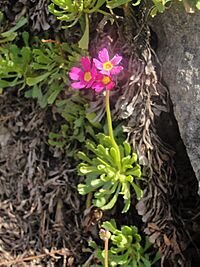
The primrose family (Primulaceae) has the alpine shooting star (Dodecatheon alpinum). It is found near streams and lakes. Also, sierra primrose (Primula suffrutescens) is considered one of the most spectacular alpine flowers. It forms large mats around rocks. It is covered with rose petals. It often grows on north-facing slopes where there is moisture from melting snow.
In the purslane family (Portulacaceae) is dwarf lewisia (Lewisia pygmaea). Some consider it "one of the most beautiful and intriguing of the alpine floral treats." It is found in higher elevation basins and slopes. It grows from 1,700 to 4,020 metres (5,580 to 13,190 ft) all the way up to 14,000 feet (4,300 m). Botanist Laird Blackwell describes its fleshy leaves. They form "amazing patterns on the ground like many-armed starfish."
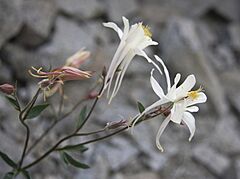
The buttercup family (Ranunculaceae) has Drummond's anemone (Anemone drummondii), a showy perennial. Alpine columbine (Aquilegia pubescens) is "among the most spectacular eastern sierra flowers." It grows as a 20 inches (0.51 m) or smaller cushion, to 12,000 feet (3,700 m). Unlike lower elevations, where hummingbirds pollinate, alpine columbine is pollinated by moths. So, its flowers are upright and white. Buttercups (Ranunculus) are among the first to bloom in the alpine zone. Alpine buttercup (R. eschscholtzii) can be found in rocky areas and meadows up to 13,000 feet (4,000 m) or 13,500 feet (4,100 m). It stands out with its bright lemon yellow flowers.
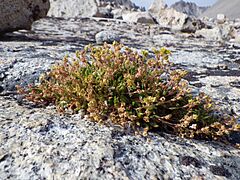
Gordon's Ivesia (Ivesia gordonii) is in the rose family (Rosaceae). It grows to elevations of 12,000 feet (3,700 m). It has intricate leaves. They are divided into many tiny leaflets. This makes them look like a "nest of green centipedes." Club-moss (Ivesia lycopodioides) is not a moss. It is a low-growing perennial. It grows in rock crevices and wet meadows. Mousetail ivesia (Ivesia santolinoides) has long, silvery leaves. It grows on gravels and ridges to 12,000 feet (3,700 m).
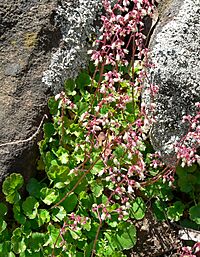
Pink heuchera (Heuchera rubescens), in the saxifrage family (Saxifragaceae), is found in dry, rocky places, to 13,000 feet (4,000 m). Grass of Parnassus (Parnassia californica) forms small patches of flowers up to 13,000 feet (4,000 m). Alpine saxifrage (Saxifraga aprica) grows in wet, rocky flats and grassy meadows. It is found in the lower alpine zone to 11,500 feet (3,500 m). Pygmy saxifrage (S. rivularis) forms small tufts 2 to 4 inches (5.1 to 10.2 cm) high. It grows in damp, shaded places under rocks. It is found from 11,000 feet (3,400 m) to over 14,000 feet (4,300 m).
Perennial Grass-like Plants
Grass-like plants (graminoids) make up 21% of the Sierra Nevada alpine species.
A common grass family (Poaceae) member is squirreltail (Elymus elymoides). Timberline bluegrass (Poa glauca) grows in the Central and Southern Sierra Nevada. It is found from 11,000 to 13,000 feet (3,400 to 4,000 m).
Sierra sedge (Carex helleri), in the sedge family (Cyperaceae), grows on gravelly and rocky slopes up to 13,600 feet (4,100 m). Alpine sedge (Carex subnigricans) is another common sedge.
Parry's rush (Juncus parryi) of the rush family (Juncaceae) grows in dry, rocky places to 12,500 feet (3,800 m).
Shrubs
Shrubs in the alpine zone are usually small and low-growing. This helps them deal with strong winds and heavy snow. They often form mats and cushions. Woody shrubs and annuals together make up only about 6% of the alpine plants.
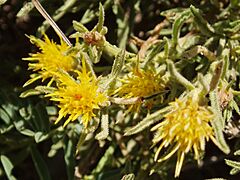
Whitestem goldenbush (Ericameria discoidea) is a compact, woody shrub. It is in the sunflower family (Asteraceae). It grows on open rocky slopes to 12,000 feet (3,700 m).
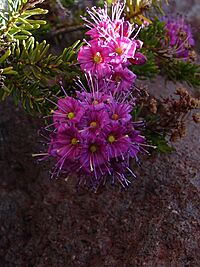
In the heath family (Ericaceae), white mountain heather (Cassiope mertensiana) is a 1 foot (0.30 m) tall shrub. It has tiny leaves and many branches. It grows on rocky ledges and in cracks up to 12,000 feet (3,700 m). Swamp laurel (Kalmia polifolia) is a low (to 8 inches (0.20 m) tall) evergreen shrub. It forms mats and grows in boggy alpine meadows or near water. It is found up to 12,000 feet (3,700 m).
Also in the heath family is purple mountain heather (Phyllodoce breweri). It is a low-growing, branched evergreen shrub. It is found in moist rocky places up to 11,500 feet (3,500 m) or 12,000 feet (3,700 m). Dwarf bilberry (Vaccinium caespitosum) is a low-growing woody plant. It creates a red and gold carpet around alpine lakes in the fall. The western Labrador teas (Rhododendron columbianum and R. neoglandulosum) are poisonous shrubs. They have fragrant white flowers. They grow in moist places up to 12,000 feet (3,700 m).
Mountain goosberry (Ribes montigenum), in the gooseberry family (Grossulariaceae), can be found as high as 14,000 feet (4,300 m).
Cliffbush (Jamesia americana) is in the mock-orange family (Hydrangeaceae). It can be found to 12,000 feet (3,700 m).
White globe gilia (Ipomopsis congesta subsp. montana), in the phlox family (Polemoniaceae), grows in mats to 12,000 feet (3,700 m). Granite gilia (Linanthus pungens) is a 4 to 12 inches (10 to 30 cm) aromatic, hairy shrub. Its needle-like leaves are adapted to the alpine climate. It grows in a sprawling way to elevations of 13,000 feet (4,000 m).

Sierra primrose (Primula suffrutescens) is in the primrose family (Primulaceae). It is a sprawling, low-growing shrub. It is found under overhanging rocks and reaches only 5 inches (0.13 m).
Creambush (Holodiscus microphyllus), a rose family (Rosaceae) member, is a 1 to 3 feet (0.30 to 0.91 m) shrub. It is found to elevations of 13,000 feet (4,000 m). Bush cinquefoil (P. fruticosa) is found around the world in northern areas. In the alpine zone, it is a dwarf shrub. It grows in moist places up to 12,000 feet (3,700 m) or 12,500 feet (3,800 m).
The mat-forming Rocky Mountain willow (Salix petrophila), in the willow family (Salicaceae), grows to only 4 inches (0.10 m). Arctic willow (Salix arctica) is tiny, creeping, and forms mats. Snow willow (Salix reticulata) grows in alpine cirques in Mono County, CA.
Other Alpine Life
The Sierra Nevada alpine zone also has lichens. These are like a mix of fungi and algae. They grow on rocks. However, the lichen growth here is not as strong as in other mountain ranges like the Rocky Mountains.



